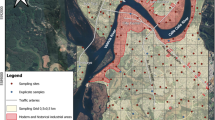Abstract
An exposure assessment was conducted on naturally metal enriched topsoils of the city of Port Macquarie in order to establish whether the soils pose any threat to human health. Surface soils (0–10 cm depth, <2 mm) were investigated for their total, bioavailable and leachable Cr and Ni concentrations. Total metal concentrations ranged from 145 to 4540 mg Cr kg−1 and 20 to 2030 mg Ni kg−1, whereas soil extractions revealed low leachable contaminant concentrations (EDTA extraction: <0.1–0.2 mg Cr L−1 and <0.1–4.7 mg Ni L−1; acetic acid extraction: <0.1 mg L−1 Cr and Ni). Thus the bioavailability of Cr and Ni to plants is low, the leaching of metals into ground and surface waters is insignificant and the pathways of these metal pollutants from topsoils into residents are limited to the inadvertent ingestion, inhalation and skin adsorption of soil metals. Simulated gastric experiments, using hydrochloric acid, indicated that less than 0.01% of the total Cr and 0.1–2.4% of the total Ni ingested are soluble and available, for uptake into the human body. Critical receptors, such as small children would have to ingest considerable soil quantities (> 11.8 g per day) over long periods of time to experience an appreciable risk of deleterious effects. Thus, although Cr and Ni are present in high concentrations, the effective uptake of Cr and Ni from soil by the majority of residents is insignificant. The possibility that the Ni enriched topsoil induces allergic contact dermatitis in sensitised individuals remains to be evaluated.
Similar content being viewed by others
References
Adamo, P., Dudka, S., Wilson, M.J. and McHardy, W.J.: 1996, Chemical and mineralogical forms of Cu and Ni in contaminated soils from the Sudbury mining and smelting region, Canada, Environmental Pollution 91, 11-19.
ANZECC (Australian and New Zealand Environment and Conservation Council) and NH&MRC (National Health and Medical Research Council): 1992, Australian and New Zealand Guidelines for the Assessment and Management of Contaminated Sites, Canberra, 57pp.
Armienta, M.A., Rodriguez, R., Ceniceros, N., Juarez, F. and Cruz, O.: 1996, Distribution, origin and fate of chromium in soils in Guanajuato, Mexico, Environmental Pollution 91, 391-397.
Bell, R.W.: 1999, Boron, in: Peverill, K.I., Sparrow, L.A. and Reuter, D.J. (eds), Soil Analysis: An Interpretation Manual, CSIRO Publishing, Melbourne, pp. 309-317.
Brooks, R.R., Lee, J., Reeves, R.D. and Jaffre, T.: 1977, Detection of nickeliferous rocks by analysis of herbarium specimens of indicator plants, Journal of Geochemical Exploration 7, 49-57.
Calabrese, E.J., Stanek, E.J., James, R.C. and Roberts, S.M.: 1997, Soil ingestion: a concern for acute toxicity in children, Environmental Health Perspectives 105, 1354-1358.
Clayton, P.M. and Tiller, K.G.: 1979, A chemical method for the determination of the heavy metal content of soils in environmental studies, Technical Paper No. 41, CSIRO Division of Soils, Adelaide.
Gasser, U.G., Juchler, S.J., Hobson, W.A. and Sticher, H.: 1995, The fate of chromium and nickel in subalpine soils derived from serpentinite, Canadian Journal of Soil Science 75, 187-195.
Imray, P. and Langley, A.: 1998, Health-based soil investigation levels, National Environmental Health Forum Monographs, Soil Series No. 1, Adelaide.
Isbell, R.F.: 1996, The Australian Soil Classification, CSIRO Publishing, Melbourne. 143pp.
Judson, G.J. and Reuter, D.J.: 1999, Selenium, in: Peverill, K.I., Sparrow, L.A. and Reuter, D.J. (eds), Soil Analysis: An Interpretation Manual, CSIRO Publishing, Melbourne, pp. 325-329.
Langley, A.: 1996, Health risk assessment and management of contaminated sites in Australia, in: Naidu, R., Kookuna, R.S., Oliver, D.P., Rogers, S. and McLaughlin, M.J. (eds), Contaminants and the Soil Environment in the Australasia-Pacific Region, Kluwer Academic Publishers, Dordrecht, pp. 281-307.
Lottermoser, B.G.: 1997, Natural enrichment of topsoils with chromium and other heavy metals, Port Macquarie, New South Wales, Australia, Australian Journal of Soil Research 35, 1165-1176.
Lyons, M.T., Brooks, R.R. and Craig, D.C.: 1974, The influence of soil composition on the vegetation of the Coolac Serpentinite Belt in New South Wales, Journal and Proceedings of the Royal Society of New South Wales 107, 67-75.
National Environment Protection Council: 1999, Investigation Levels for Soil and Groundwater, Draft Guideline 1, Schedule B (1), 10pp.
Sheppard, S.C.: 1998, Geophagy: who eats soil and where do possible contaminants go? Environmental Geology 33, 109-114.
US EPA: 1986a, Method 3050B: acid digestion of sediments, sludges and soils. Test methods for evaluating solid waste, US EPA Publication SW-846, 3rd edition.
US EPA: 1986b, Method 1311: toxicity characteristics leaching procedure. Test methods for evaluating solid waste, US EPA Publication SW-846, 3rd edition.
Author information
Authors and Affiliations
Rights and permissions
About this article
Cite this article
Lottermoser, B. Exposure Assessment of Naturally Metal Enriched Topsoils, Port Macquarie, Australia. Environmental Geochemistry and Health 24, 183–190 (2002). https://doi.org/10.1023/A:1016056615002
Issue Date:
DOI: https://doi.org/10.1023/A:1016056615002




